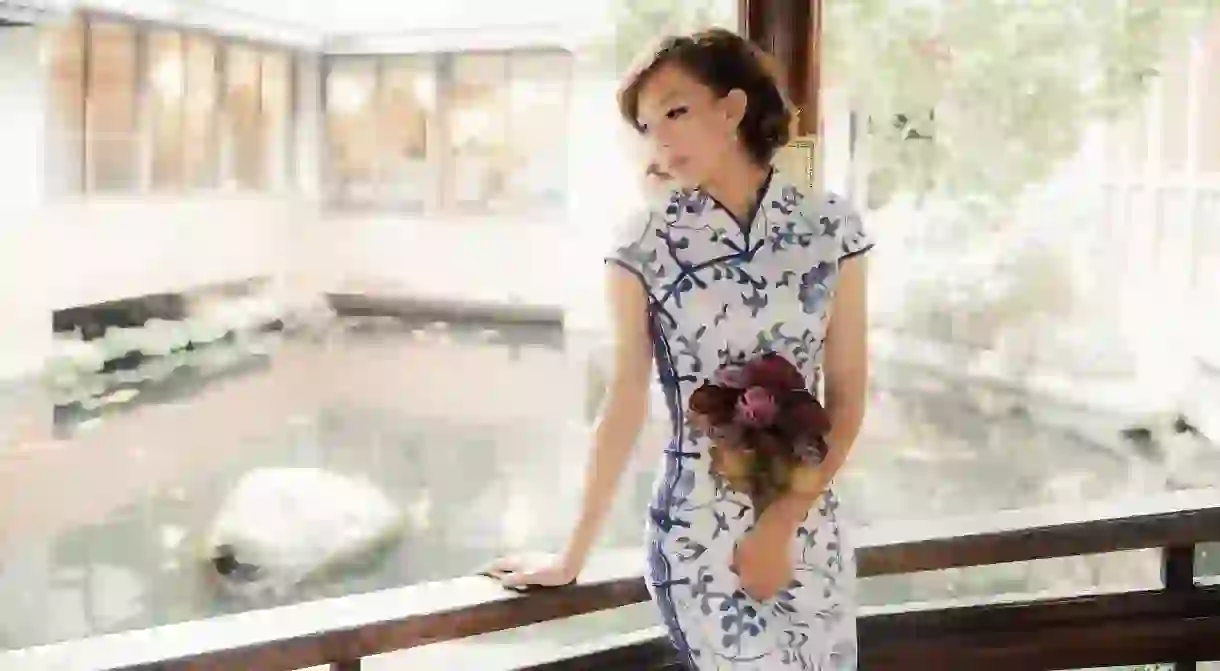A Brief History Of The Cheongsam

The cheongsam, also known as a qipao, is a close-fitting dress that originated in 1920s Shanghai. It quickly became a fashion phenomenon that was adopted by movie stars and schoolgirls alike. The history of this iconic garment reflects the rise of the modern Chinese woman in the twentieth century.
The story of the cheongsam starts with the overthrow of the Qing dynasty and founding of the Republic of China in 1912. In the mid-1910s and early 1920s, Chinese intellectuals began to revolt against traditional values, calling instead for a democratic and egalitarian society based on Western standards, including the emancipation and education of women. Foot-binding, the painful practice of binding young girl’s feet to prevent their growth, was outlawed.
As women were allowed into the education system starting in the 1920s, becoming teachers and university students, they shed the traditional, ornate robes of the olden days and adopted an early form of the cheongsam, which emerged from the androgynous men’s garment called the changpao. Shanghai, an active and vibrant port city with a large population of foreigners, was at the cutting edge of this fashion shift.

The cheongsam of the early 1920s had a looser cut than the cheongsam of today, with long, wide sleeves. It quickly became the regular outfit of urban women in metropolitan cities like Beijing, Shanghai, Hong Kong, and Taiwan. As the garment evolved, traditional silks were replaced with cheaper, contemporary textiles. In terms of design, the traditional embroidered florals remained widespread, but geometric and art deco patterns also gained popularity.
Through the 1930s and 1940s, the cheongsam continued to change, accentuating the femininity and sexuality of the urban Chinese woman. The dress became more fitted and body-hugging, with some daring designs featuring side slits that reached up to the thigh. It became customary to pair the dress with high heels. Women experimented with different fastenings, pipings, and collars, as well as short-capped sleeves, long sleeves with fur-lined cuffs, and sleeveless cheongsams.
However, shortly after the rise of the Communist government, the cheongsam, which was considered bourgeois, disappeared from everyday life in mainland China. In Shanghai, the birthplace of the cheongsam, the streets were patrolled to ensure that nobody wore fashionable clothing. The egalitarian ideology espoused by the Communists led women to adopt a tunic consisting of a jacket and trousers similar to the men’s.

Nevertheless, the cheongsam’s popularity continued in the British colony of Hong Kong, where it became everyday wear in the 1950s. Under the influence of European fashion, it was typically worn with high heels, a leather clutch, and white gloves. Movies such as The World of Suzie Wong (1961), as well as the rise of Hong Kong beauty pageants, cemented the garment’s association with Hong Kong in the international consciousness.
By the end of the ’60s, the popularity of the cheongsam declined, giving way to Western-style dresses, blouses, and suits. These mass-produced Western clothes were cheaper than handmade cheongsams, and by the early 1970s, it no longer constituted everyday wear for most Hong Kong women. However, it remains a significant garment in the history of Chinese women’s fashion.













